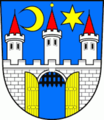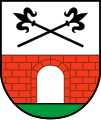Gate (heraldry)


The gate , also the portal , is a common figure in heraldry and therefore a coat of arms . The term gate is also used less frequently . The figure is one of the common heraldic images. An open gate to a community / city is often interpreted as cosmopolitan.
The gate can be displayed as a single structure or in another structure, such as a wall , castle , fort or tower . This is an essential point when describing the coat of arms .
Heraldry then makes the following differences:
- The gate is open or closed
- The gate has one or two doors. Two doors, closed, are represented by a line in the middle of the gate.
- The opened gate is doorless / scoreless or a wing gate / door is shown on the left and right.
- The gate is shown with a closed (closed) or pulled (open) grille . The color of the gate is also important here. Occasionally open doors are also possible, which allow a view of the grille.
- A coat of arms is shown in the open archway.
The door or the gate wing (s) have a different tinging than the heraldic figure gate or the building. In heraldry, the figure gate is also differentiated according to castle gate, fortress gate, church door, Byzantine gate, etc.
Examples
Blovice , open gate
Bondo GR with a black ibex in the archway
with drawn silver grille and golden lion in the coat of arms of Dillenburg
open gate in the coat of arms of Dühren (Sinsheim)
Closed gate in a palisade wall in the coat of arms of Srubec
Open swing gate with a cock on a three hill in the archway in the coat of arms of Suhl
literature
- Gert Oswald : Lexicon of Heraldry . VEB Bibliographisches Institut, Leipzig 1984, ISBN 3-411-02149-7 , p. 396.
Web links
- Gate (Heraldry) in the Heraldry Wiki





